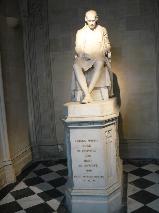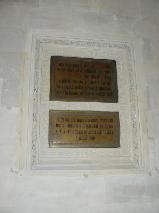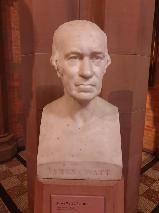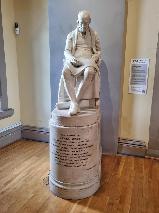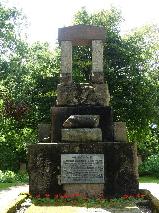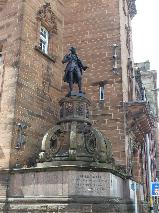Watt, James |
| INVENTOR, MECHANICAL ENGINEER, CHEMIST (SCOTLAND) |
|
BORN 29 Jan 1736, Greenock, Renfrewshire - DIED 19 Aug 1819, Heathfield, West Midlands (near Birmingham) GRAVE LOCATION Birmingham, West Midlands: St. Mary's Church, Hamstead Road, Handsworth |
|
James Watt was the son of another James Watt (1698-1782) and his wife Agnes Muirhead (1703-1755). His father was a shipowner and chief baillie of Greenock in 1751. He attended Greenock Grammar School before he showed his skill in creating engineering models in his father's workshops. He left Greenock for Glasgow to work as a mathematical instrument maker. When he was 18 years old he went to London where he was trained as an instrumentmaker. After his return to Glasgow he restored the instruments that Alexander MacFarlane had bequeathed to Glasgow University. In 1759 he partnered for six years with John Craig to sell musical instruments, toys and other products. On 14 July 1764 he married his cousin Margaret Miller. She died in 1773 when giving birth to their fith child. In 1777 he married Ann MacGregor (d.1832). They had two children. In 1763 Watt repaired a Newcomen engine but it was hardly effective even when it worked. In 1765 he suddenly realised how he could improve it. John Roebuck backed him financially in constructing a full-scale steam engine. After Roebuck went bankrupt Matthew Boulton bought the patent rights and they formed the partnership Boulton and Watt for 25 years. By 1776 their engines were commercially successful. They were constructed by others after drawings by Watt who was worked as a consulting engineer. Further improvements and patents followed. Watt was also interested in chemistry. In 1786 in Paris he observed the experiments by Claude Louis Berthollet that produced chlorine. Watt experimented in England in search of a commercially viable process. His father-in-law James McGrigor, used his results commercially. But after Berthollet published new results Watt and his father-in-law were overtaken by rivals. Edward Bull first built engines for Boulton and Watt but in 1792 he started making engines of his own design and others infringed Watt's patents as well. He sued Bull but it remained unclear if his original patents were valid. In 1799 he won a case against Jonathan Hornblower. In 1800 Watt retired after his most important patent expired and his partnership with Boulton ended. Their sons Matthew Robinson Boulton and James Watt junior continued the company in partnership with the engineer William Murdoch. Watt continued his work as an inventor and he constructed machines for copying medallions that he never patented. He lived at Heathfield Hall in Handsworth, Birmingham and he travelled to France and Germany with his wife. He owned a second house in Wales. He died in 1819 in Handsworth and was buried at the churchard of St. Mary's church. The church was expanded over his grave and it is now located within the church. |
Sources • Pearson, Hesketh, Extraordinary People, Heinemann, London, 1965 • Uglow, Jenny, The Lunar Men, Farrar, Straus and Giraux, New York, 2002 • James Watt - Wikipedia (EN) |

